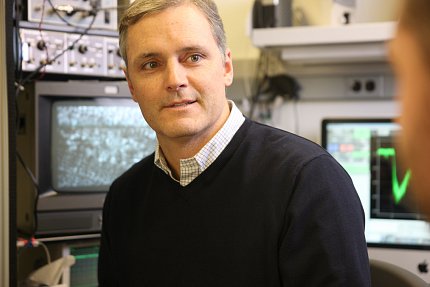Diamond Named NINDS Scientific Director

Neuroscientist Dr. Jeffrey S. Diamond was recently named scientific director at the National Institute of Neurological Disorders and Stroke (NINDS). A senior investigator in NINDS’s synaptic physiology section, he has served as the institute’s acting scientific director since August 2022.
“I am confident that Dr. Diamond will provide leadership that will build on our Intramural Research Program’s incredible strengths and continue NINDS efforts to create a vibrant, productive research community that is a welcoming and fulfilling workplace and training environment for all,” said NINDS Director Dr. Walter Koroshetz.
Diamond received his undergraduate degree from Duke University and his Ph.D. from the University of California, San Francisco, where he studied excitatory synaptic transmission in the retina.
During a postdoctoral fellowship at the Vollum Institute—an independent research institute located on the campus of Oregon Health and Science University—he investigated the effects of glutamate transporters on excitatory synaptic transmission in the hippocampus. Diamond joined NINDS as an investigator in 1999 and was promoted to senior investigator in 2007.
As scientific director, he will oversee NINDS’s Intramural Research Program (IRP), which consists of 48 labs and approximately 1,100 employees at NIH. IRP scientists conduct research on basic, translational and clinical neuroscience in areas such as synaptic transmission, movement disorders, structural neurobiology, biophysics, neurodegeneration, neural circuits, neuropharmacology, neurodevelopment, stroke, brain imaging, neurogenetics and neuroimmunology.
“This past year as acting scientific director has exposed me to many of the responsibilities, challenges and exciting opportunities that come with the position,” said Diamond. “I look forward to learning much more and serving our intramural community going forward.”
Diamond’s laboratory seeks to understand how neural circuits receive, compute, encode and transmit information. His research focuses on how synapses, neurons and small circuits perform computational tasks required for visual information processing in the mammalian retina.
Throughout his career, he has earned many awards and honors, including the Presidential Early-Career Award in Science and Engineering. He follows Dr. Lorna Role, who served as NINDS scientific director until May 2021.—Shannon E. Garnett
